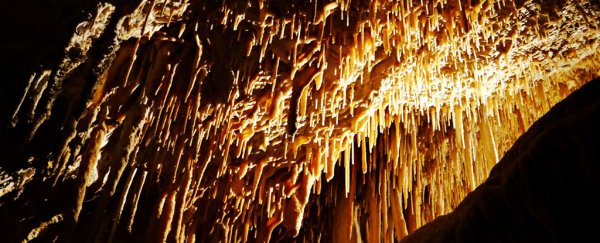To those of us spending nearly all of our time above ground, cool and damp underground caves might not seem like they have an awful lot to do with climate change. But the geochemical composition of mineral deposits called speleothems – ie. the stalactites and stalagmites you learned about in primary school – can actually tell us a whole lot about the climates of times past.
A new study led by Australian researchers has found that wildfires burning on the surface can elicit a 'post-wildfire response' in the cave networks below, with cave formations affected by the water that drips down from charred environments above. And it turns out that the geochemical deposits left behind in caves after a wildfire can be a pretty effective doppelgänger for signs of climate change in Earth's history.
"It really needs to be brought to people's attention," paleoclimateologist Pauline Treble from the Australian Nuclear Science and Technology Organisation (ANSTO) told Sarah Scoles at Smithsonian. "Otherwise there's plenty of potential for people to be misinterpreting those proxies."
Treble and her team – including Gurinder Nagra from UNSW Australia, who was lead author on the paper – were initially investigating Yonderup Cave in Western Australia's Yanchep National Park, to extract rainfall information from the speleothems in the cave. Ordinarily, these cave formations contain compounds that enable them to be dated, and isotopic records can be used to examine ancient climate conditions.
But, strangely enough, not in Yonderup Cave. "There should have been a clear signal," Treble told Smithsonian, but there wasn't. When she remembered that Yanchep National Park had suffered an intense wildfire in February 2005, Treble wondered if that was what was altering the chemical composition in the cave.
The team analysed the dripwater deposits in the cave and found that post-fire water was more chlorinated and also richer in potassium and sulphate than dripwater data from another cave in southwest Australia. It also had an altered oxygen isotope ratio – which paleoclimateologists ordinarily use to detect climate variability in mineral deposits.
While the ratio was only two parts per thousand different to the usual dripwater oxygen isotope ratio, that subtle change could make all the difference if scientists were trying to measure historical climates. As Scoles explains:
"Such a seemingly small change is actually on par with the largest climate fluctuations from about 2.6 million years ago to the present. Scientists, the team discovered, might be misreading oxygen ratios as big swings in climate when they are actually seeing big flames."
The findings, currently in review prior to publication in Hydrology and Earth System Sciences, will hopefully help geologists and climate researchers avoid using compromised caves when recording data – or at least take wildfires into account when making their measurements.
"In essence, the scientist must try to understand the cave system and even the dripwater system from which his or her stalagmite has been sampled to properly interpret the more subtle changes," researcher Frank McDermott from University College Dublin in Ireland, who was not involved with the study, told Smithsonian.
Nobody ever said science was easy.
ANSTO is a sponsor of ScienceAlert. Find out more about ANSTO's cutting-edge research.
